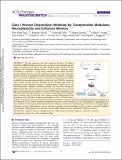| dc.contributor.author | Zhao, Wen-Ning | |
| dc.contributor.author | Ghosh, Balaram | |
| dc.contributor.author | Tyler, Marshall | |
| dc.contributor.author | Lalonde, Jasmin | |
| dc.contributor.author | Joseph, Nadine F. | |
| dc.contributor.author | Kosaric, Nina | |
| dc.contributor.author | Fass, Daniel M. | |
| dc.contributor.author | Tsai, Li-Huei | |
| dc.contributor.author | Mazitschek, Ralph | |
| dc.contributor.author | Haggarty, Stephen J. | |
| dc.date.accessioned | 2020-07-24T17:30:05Z | |
| dc.date.available | 2020-07-24T17:30:05Z | |
| dc.date.issued | 2018-06 | |
| dc.date.submitted | 2018-03 | |
| dc.identifier.issn | 1948-7193 | |
| dc.identifier.issn | 1948-7193 | |
| dc.identifier.uri | https://hdl.handle.net/1721.1/126372 | |
| dc.description.abstract | Through epigenetic and other regulatory functions, the histone deacetylase (HDAC) family of enzymes has emerged as a promising therapeutic target for central nervous system and other disorders. Here we report on the synthesis and functional characterization of new HDAC inhibitors based structurally on tianeptine, a drug used primarily to treat major depressive disorder (MDD) that has a poorly understood mechanism of action. Since the chemical structure of tianeptine resembles certain HDAC inhibitors, we profiled the in vitro HDAC inhibitory activity of tianeptine and demonstrated its ability to inhibit the lysine deacetylase activity of a subset of class I HDACs. Consistent with a model of active site Zn2+ chelation by the carboxylic acid present in tianeptine, newly synthesized analogues containing either a hydroxamic acid or ortho-aminoanilide exhibited increased potency and selectivity among the HDAC family. This in vitro potency translated to improved efficacy in a panel of high-content imaging assays designed to assess HDAC target engagement and functional effects on critical pathways involved in neuroplasticity in both primary mouse neurons and, for the first time, human neurons differentiated from pluripotent stem cells. Most notably, tianeptinaline, a class I HDAC-selective analogue of tianeptine, but not tianeptine itself, increased histone acetylation, and enhanced CREB-mediated transcription and the expression of Arc (activity-regulated cytoskeleton-associated protein). Systemic in vivo administration of tianeptinaline to mice confirmed its brain penetration and was found to enhance contextual fear conditioning, a behavioral test of hippocampal-dependent memory. Tianeptinaline and its derivatives provide new pharmacological tools to dissect chromatin-mediated neuroplasticity underlying memory and other epigenetically related processes implicated in health and disease. | en_US |
| dc.language.iso | en | |
| dc.publisher | American Chemical Society (ACS) | en_US |
| dc.relation.isversionof | http://dx.doi.org/10.1021/acschemneuro.8b00116 | en_US |
| dc.rights | Article is made available in accordance with the publisher's policy and may be subject to US copyright law. Please refer to the publisher's site for terms of use. | en_US |
| dc.source | Other repository | en_US |
| dc.title | Class I Histone Deacetylase Inhibition by Tianeptinaline Modulates Neuroplasticity and Enhances Memory | en_US |
| dc.type | Article | en_US |
| dc.identifier.citation | Zhao, Wen-Ning et al. "Class I Histone Deacetylase Inhibition by Tianeptinaline Modulates Neuroplasticity and Enhances Memory." ACS Chemical Neuroscience 9, 9 (June 2018): 2262–2273 © 2018 American Chemical Society | en_US |
| dc.contributor.department | Massachusetts Institute of Technology. Department of Brain and Cognitive Sciences | en_US |
| dc.relation.journal | ACS Chemical Neuroscience | en_US |
| dc.eprint.version | Author's final manuscript | en_US |
| dc.type.uri | http://purl.org/eprint/type/JournalArticle | en_US |
| eprint.status | http://purl.org/eprint/status/PeerReviewed | en_US |
| dc.date.updated | 2019-10-09T12:44:38Z | |
| dspace.date.submission | 2019-10-09T12:44:44Z | |
| mit.journal.volume | 9 | en_US |
| mit.journal.issue | 9 | en_US |
| mit.metadata.status | Complete | |

